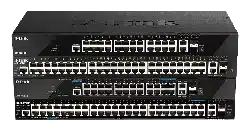Loading ...
Loading ...
Loading ...

DGS-1520 Series Gigabit Ethernet Smart Managed Switch Web UI Reference Guide
188
Parameter Description
VID Enter a VLAN ID between 1 and 4094. This is available when VLAN is selected in
the Statistics drop-down list.
Unit
Select the Switch unit that will be used for this configuration here. This is available
when Port is selected in the Statistics drop-down list.
From Port - To Port
Select the appropriate port range used for the configuration here. This is available
when Port is selected in the Statistics drop-down list.
Click the Clear button to clear the IGMP snooping related statistics.
The fields that can be configured in IGMP Snooping Statistics Table are described below:
Parameter Description
Find Type Select the interface type. Options to choose from are VLAN, and Port.
VID
Enter a VLAN ID between 1 and 4094.
This is available when VLAN is selected in the Find Type drop-down list.
Unit
Select the Switch unit that will be used for this configuration here.
This is available when Port is selected in the Find Type drop-down list.
From Port - To Port
Select the appropriate port range used for the configuration here.
This is available when Port is selected in the Find Type drop-down list.
Click the Find button to locate a specific entry based on the information entered.
Click the Show All button to view all the entries.
Enter a page number and click the Go button to navigate to a specific page when multiple pages exist.
MLD Snooping
Multicast Listener Discovery (MLD) Snooping is an IPv6 function used similarly to IGMP snooping in IPv4. It is used to
discover ports on a VLAN that are requesting multicast data. Instead of flooding all ports on a selected VLAN with
multicast traffic, MLD snooping will only forward multicast data to ports that wish to receive this data through the use
of queries and reports produced by the requesting ports and the source of the multicast traffic.
MLD snooping is accomplished through the examination of the layer 3 part of an MLD control packet transferred
between end nodes and a MLD router. When the Switch discovers that this route is requesting multicast traffic, it adds
the port directly attached to it into the correct IPv6 multicast table, and begins the process of forwarding multicast
traffic to that port. This entry in the multicast routing table records the port, the VLAN ID, and the associated multicast
IPv6 multicast group address, and then considers this port to be an active listening port. The active listening ports are
the only ones to receive multicast group data.
MLD Control Messages
These types of messages are transferred between devices using MLD snooping. These messages are all defined by
four ICMPv6 packet headers, labeled 130, 131, 132, and 143.
• Multicast Listener Query - Similar to the IGMPv2 Host Membership Query for IPv4, and labeled as 130 in the
ICMPv6 packet header, this message is sent by the router to ask if any link is requesting multicast data. There
are two types of MLD query messages emitted by the router: the General Query, which is used to advertise all
multicast addresses that are ready to send multicast data to all listening ports, and the Multicast Specific query,
which is used to advertise a specific multicast address that is also ready. These two types of messages are
distinguished by a multicast destination address located in the IPv6 header and a multicast address in the
Multicast Listener Query Message.
• Multicast Listener Report, Version 1 - Comparable to the Host Membership Report in IGMPv2, and labeled
as 131 in the ICMP packet header, this message is sent by the listening port to the Switch stating that it is
interested in receiving multicast data from a multicast address in response to the Multicast Listener Query
message.
Loading ...
Loading ...
Loading ...
